Pokemon GO! at the Library
By Katy Searcy, Children’s Department
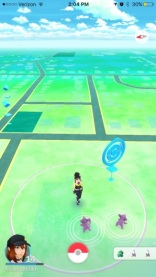 At this point, we’ve all heard something about the wildly popular game Pokémon Go. You know, the game that has players falling off cliffs and running into oncoming traffic. The game that many players claim has improved their mental health. Maybe you know it as the game that finally got your kids off the couch and walking around outside. Either way, Pokémon Go really is a great way for people of all ages to spend some time in the great outdoors, especially as the weather changes. And we’re here to give you the basics and some tips on how to play (especially after helping numerous children catch pokemon at the library).
At this point, we’ve all heard something about the wildly popular game Pokémon Go. You know, the game that has players falling off cliffs and running into oncoming traffic. The game that many players claim has improved their mental health. Maybe you know it as the game that finally got your kids off the couch and walking around outside. Either way, Pokémon Go really is a great way for people of all ages to spend some time in the great outdoors, especially as the weather changes. And we’re here to give you the basics and some tips on how to play (especially after helping numerous children catch pokemon at the library).
Pokémon Go was created by Niantic, Inc. as a way to get players out of the house and exploring their neighborhoods and cities. It’s similar to geocaching, but without finding physical objects. Pokémon are spawned based on the player’s geographic location, which is tracked through the GPS in the player’s smartphone. As you move, your avatar moves in the game, and the more you move, the better your chances for finding Pokémon.
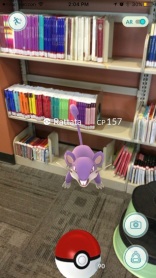 Pokémon fall into different categories, or “types.” Each Pokémon is typically found in a location correlating to its type. For instance, Water Pokémon are found near bodies of water (ponds, rivers, lakes, oceans, etc.), Grass Pokémon and Bug Pokémon are in particularly grassy areas (parks, golf courses, nature trails, etc.), and Normal Pokémon can be found in residential areas. These Pokémon are more common in this area, although that doesn’t mean you won’t come across a different type. You can also hatch Pokémon from eggs collected from PokéStops, and in order to hatch them, you have to walk. Each egg hatches after a certain predetermined distance—2 km, 5 km, or 10 km—, and the greater the distance walked, the rarer the Pokémon hatched.
Pokémon fall into different categories, or “types.” Each Pokémon is typically found in a location correlating to its type. For instance, Water Pokémon are found near bodies of water (ponds, rivers, lakes, oceans, etc.), Grass Pokémon and Bug Pokémon are in particularly grassy areas (parks, golf courses, nature trails, etc.), and Normal Pokémon can be found in residential areas. These Pokémon are more common in this area, although that doesn’t mean you won’t come across a different type. You can also hatch Pokémon from eggs collected from PokéStops, and in order to hatch them, you have to walk. Each egg hatches after a certain predetermined distance—2 km, 5 km, or 10 km—, and the greater the distance walked, the rarer the Pokémon hatched.
When you come upon a Pokémon, your phone will vibrate to let you know you found something. You tap on the Pokémon that appears on your screen, and from there, the app uses augmented reality through your phone’s camera, so it looks like the Pokémon is there in the real world. You’ll be prompted to “catch” it with a Poké Ball, and you throw the ball by swiping up on the screen with your finger to hit the Pokémon in the circle.
There are locations scattered around town called PokéStops and Gyms that are usually found either along nature trails, historic sites, churches, public buildings, and other interesting local locations. Stops are places players can visit to get supplies, and Gyms are for battling. The library is a PokéStop, and since we’re in a historic part of town, there are lots of Stops and Gyms around us. Lure modules can be placed at Stops, which lure Pokémon to the Stop for thirty minutes.
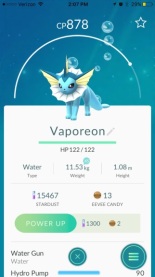 Once caught, you can make Pokémon stronger by powering them up or evolving them using the stardust and candy that you get when you catch a Pokémon. You can also transfer your Pokémon to get candy, which is especially helpful when you have lots of low CP, common Pokémon. The more Pokémon you catch, the more stardust and candy you get. When you’ve reached Level 5, you can battle other players’ Pokémon and train your Pokémon at Gyms.
Once caught, you can make Pokémon stronger by powering them up or evolving them using the stardust and candy that you get when you catch a Pokémon. You can also transfer your Pokémon to get candy, which is especially helpful when you have lots of low CP, common Pokémon. The more Pokémon you catch, the more stardust and candy you get. When you’ve reached Level 5, you can battle other players’ Pokémon and train your Pokémon at Gyms.
The best spots to catch Pokémon are typically places that are heavily populated or where there are lots of active users, such as Cool Springs or downtown Franklin. PokéStops will give you more items, and you’ll find better Pokémon if you’re in a bigger area. Landmarks and other places of interest are good to try, too. You’ll find better and rarer Pokémon as your trainer level advances, so don’t be discouraged if you don’t catch anything amazing at first.
“What does all this have to do with the library, of all places?” you might be thinking. As I mentioned earlier, the Main Branch of WCPL in Franklin is a PokéStop itself, with tons of other Stops and a couple of Gyms within walking distance. It would be a great starting place for anyone wanting to walk around and catch Pokémon. Starting in the back of our parking lot, you could walk along Columbia Avenue towards downtown, picking up seven or eight Stops along the way. I’ve personally caught decent Pokémon—like Pinsirs and Scythers—in the library, and I’ve seen people catch Glooms, Arboks, and Wigglytuffs. We’ve also been known to drop Lures at some of our library events, so you never know what you might find here.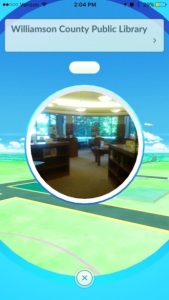
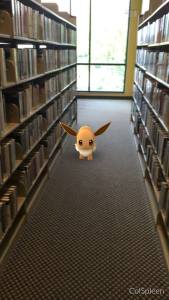
Posted on September 9, 2016, in Hot Topics, Kids and tagged Katy Searcy, Pokemon, Pokemon Go, PokeStop. Bookmark the permalink. Leave a comment.
Leave a comment
Comments 0